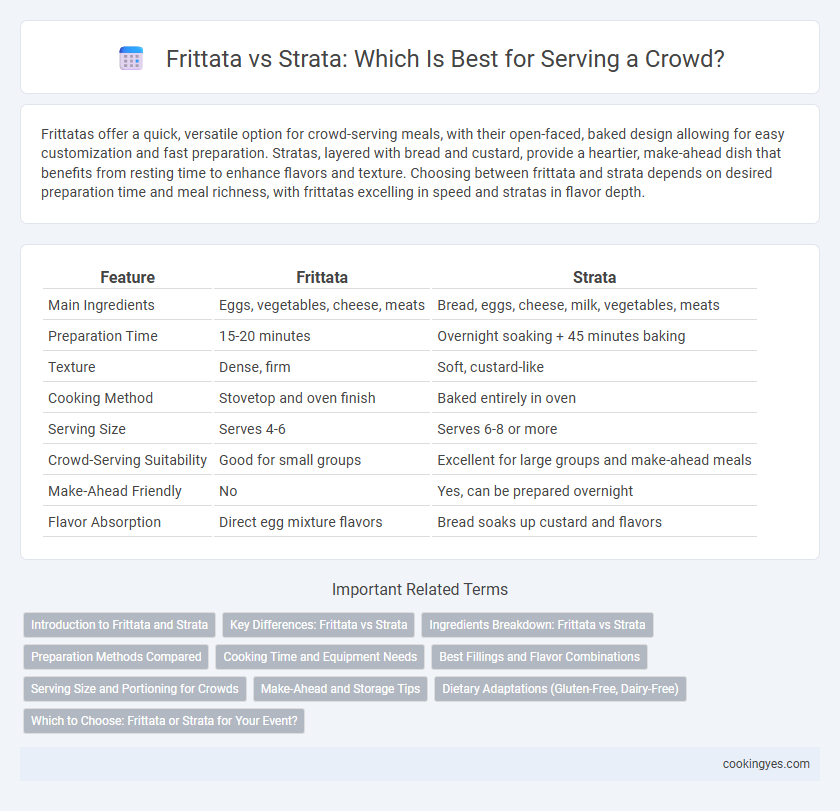Frittatas offer a quick, versatile option for crowd-serving meals, with their open-faced, baked design allowing for easy customization and fast preparation. Stratas, layered with bread and custard, provide a heartier, make-ahead dish that benefits from resting time to enhance flavors and texture. Choosing between frittata and strata depends on desired preparation time and meal richness, with frittatas excelling in speed and stratas in flavor depth.
Table of Comparison
| Feature | Frittata | Strata |
|---|---|---|
| Main Ingredients | Eggs, vegetables, cheese, meats | Bread, eggs, cheese, milk, vegetables, meats |
| Preparation Time | 15-20 minutes | Overnight soaking + 45 minutes baking |
| Texture | Dense, firm | Soft, custard-like |
| Cooking Method | Stovetop and oven finish | Baked entirely in oven |
| Serving Size | Serves 4-6 | Serves 6-8 or more |
| Crowd-Serving Suitability | Good for small groups | Excellent for large groups and make-ahead meals |
| Make-Ahead Friendly | No | Yes, can be prepared overnight |
| Flavor Absorption | Direct egg mixture flavors | Bread soaks up custard and flavors |
Introduction to Frittata and Strata
Frittata and strata both serve as versatile egg-based dishes ideal for crowd-serving meals, with the frittata originating from Italy and characterized by its open-faced, omelette-like preparation enriched with vegetables, meats, and cheeses. Strata, a layered casserole primarily found in American brunch cuisine, combines bread, eggs, cheese, and often vegetables or sausage, allowing it to be baked and sliced for easy serving. The key distinction lies in frittata's stovetop and oven-cooked method with a dense, cohesive texture, while strata offers a custardy, baked casserole that soaks through the bread layers.
Key Differences: Frittata vs Strata
Frittata and strata both serve as versatile crowd-friendly dishes, but key differences distinguish them. Frittata is an Italian-style egg-based dish cooked on the stovetop and finished in the oven, featuring a denser, thicker texture without bread layers. Strata, an American breakfast casserole, incorporates bread, eggs, and cheese to create a layered, custard-like consistency ideal for make-ahead meals and reheating.
Ingredients Breakdown: Frittata vs Strata
Frittata primarily combines beaten eggs with solid ingredients like vegetables, cheese, and meats directly mixed in before cooking, resulting in a dense, cohesive texture. Strata layers bread soaked in egg custard with vegetables, cheese, and meats, creating a casserole-like dish with a softer, more custardy interior. The ingredient breakdown highlights frittata's emphasis on eggs as the base, while strata incorporates bread as a key component to serve larger crowds effectively.
Preparation Methods Compared
Frittata preparation involves whisking eggs with ingredients and cooking slowly on the stovetop before finishing under the broiler, making it ideal for quick assembly and serving smaller groups. Strata requires layering bread, cheese, and other fillings, then soaking the mixture in egg custard before baking, which suits larger gatherings due to its make-ahead convenience and portion control. Both dishes offer versatile crowd-pleasing options, but stratas benefit from overnight prep while frittatas demand immediate cooking.
Cooking Time and Equipment Needs
Frittatas cook quickly on the stovetop or in the oven, requiring only a skillet and minimal prep time, making them ideal for fast, crowd-serving meals. Stratas need longer baking times, often over an hour, and require a casserole dish, which can be less convenient for quick service but excels at advance preparation. The faster cooking and simple equipment needs of frittatas provide a practical advantage when feeding large groups efficiently.
Best Fillings and Flavor Combinations
Frittatas offer a versatile base for crowd-serving meals, with best fillings including spinach, mushrooms, feta, and sun-dried tomatoes, creating a rich blend of savory flavors. Strata, a layered casserole of bread, eggs, cheese, and fillings like sausage, bell peppers, and cheddar, provides a hearty option with a custard-like texture. Combining fresh herbs such as basil or thyme with strong cheeses enhances both dishes' flavor profiles, making them ideal for satisfying large groups.
Serving Size and Portioning for Crowds
Frittatas offer individual-sized servings that simplify portion control for crowd-serving meals, making it easier to accommodate varying appetites. Strata, typically baked in a large casserole dish, requires slicing into portions, which can lead to inconsistent serving sizes and potential waste. For events where precise portioning and ease of distribution are priorities, frittatas provide a more practical and efficient solution.
Make-Ahead and Storage Tips
Frittatas can be made ahead and stored in the refrigerator for up to four days, making them convenient for quick reheating in large portions, while maintaining a tender texture. Stratas, which rely on soaking bread in eggs and milk overnight, benefit from being assembled the night before and refrigerated, allowing flavors to meld and simplify morning preparations. For both dishes, storing tightly covered in an airtight container preserves freshness and prevents moisture loss, ensuring optimal taste and texture when served to a crowd.
Dietary Adaptations (Gluten-Free, Dairy-Free)
Frittatas offer greater flexibility for dietary adaptations, as they can easily be made gluten-free and dairy-free by omitting breadcrumb toppings and substituting cheese with plant-based alternatives. Stratas typically contain bread and dairy, making gluten-free and dairy-free modifications more challenging and often requiring recipe restructuring. Choosing frittatas for crowd-serving meals simplifies accommodating guests with gluten and dairy sensitivities while maintaining rich flavor and texture.
Which to Choose: Frittata or Strata for Your Event?
Frittatas offer a quick, customizable option with a firm texture and are ideal for serving warm, individual portions at events. Strata features layered bread, eggs, and cheese, providing a custard-like consistency and can be prepared in advance, making it perfect for large gatherings requiring overnight refrigeration. Choose a frittata for ease of preparation and flexibility or a strata for its make-ahead convenience and satisfying, hearty flavor profile.
Frittata vs Strata for Crowd-Serving Meals Infographic

 cookingyes.com
cookingyes.com